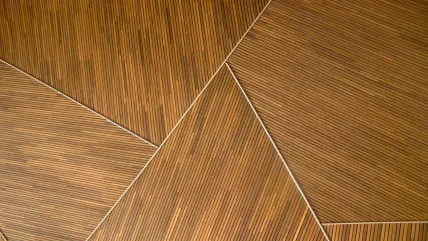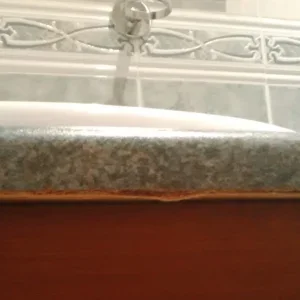
Delegates attending this year’s European Wood-based Panels Symposium in Hamburg (see pp24-28) would have noticed one sponsor showcasing its fire retardant technology for wood-based panels.
Canada-based Zeroignition (Zi), which showed MDF and particleboard samples treated with its FR treatment at the event, believes its extensive R&D work has positioned it well to offer the global wood based panels industry a low-cost, non-toxic fire treatment that is applied as part of the board manufacturing process.
Zi works with construction component manufacturers across the world and services a wide range of materials in the wood sector including wood-based panels, engineered wood, solid wood, modified wood and wood plastic composites.
Martin Dickie, Zi’s vice-president business development EMEA, took time out of the event to speak to WBPI about the company’s progress in the panels sector. He handed out numerous samples to delegates and reported high interest levels.
He explained that Zi’s research is conducted across Europe, including Greece, Spain, Ireland and the UK.
The Greek laboratory in particular had been focused on FR solutions for woodbased panels, working in partnership with nearby resins/binders specialists Chimar Hellas so the relationship of fire retardant and resin could be optimised.
OSB INITIAL TARGET MARKET
OSB was Zi’s first target for application in the wood-based panels sector, then particleboard and MDF.
The SMARTPLY OSB factory in Ireland was the first in-line application for Zi in the board sector using its water-based FR chemical, which allows the manufacturer to reduce the amount of water used in the production process and keep solid content high.
This flame retardant structural OSB3 panel, launched in 2017, meets European reaction to fire class C-s2,d0 and Bfl –s1 performance and since 2021 fire class Euro B.
The panel also complies with the FR/FR Build performance requirements in accordance with the UK Structural Timber Association’s ‘Design guide to separating distances during construction’.
Mr Dickie said the Covid crisis gave Zi a chance to re-look at its technology and its applications.
Pre-Covid, the company had one type of chemistry for its FR product but learned that it needed to have more than one formulation due to different panel types, different manufacturers and different line production speeds.
This optimisation, he says, is allowing it to deliver additional efficiencies to customers. Zi has also managed to achieve a 65% solid content for particleboard application, which means the FR can effectively be blended with the resin at the beginning of the production process.
The Zi FR chemical has the right balance of water added to it to replace the traditional water input in the blending process.
This, said Mr Dickie, has advantages over traditional FR treatment, which typically uses a dry powder process onto the surface and in the core.
This powder process, he added, was not easy and often results in an overuse of FR to attain required performance, while FR powders have inherent process issues such as clumping and clogging in the production process, which can be further impacted through hot weather extremes, as witnessed over the last couple of years.
Aside from efficiency and performance benefits of Zi’s in-line treatment method (Zi says treatment has no impact on physical board characteristics compared to nontreated board), Zi says the liability for the panel’s performance is able to sit with the board manufacturer, “as it should be”, said Mr Dickie. That’s because post-production processes by customers, such as cutting, wouldn’t impact the FR capabilities due to the in-line through board treatment of the panel.
For instance, the SMARTPLY Flame Retardant OSB3 panels are CE marked at the source of manufacture and stay certified regardless of if they are cut, fixed or machined.
The product has found a ready market in roofing, flooring and wall sheathing applications where strength, moisture resistance and flame retardance are paramount.
BOOSTING EFFICIENCY
Zi says the 65% solids level allows for effective in-line treatment in particleboard production, saving 10% production time and 15% on the cost of board compared to traditional FR in-line treatment methods.
“This enables wood-based panels manufacturers to hold their margins,” Mr Dickie explained.
Mr Dickie said all board manufacturers needed was effectively a storage tank for the Zi solution, a pump, pipes and of course the Zi solution itself. He said this is such a small amount of equipment and capital investment to get up and running.
“Somebody who wants to get into the FR market does not have to make an enormous investment,” he added.
“My view on the FR market is that the more in-line FR process product becomes available, the more the market will grow.”
At the Symposium, 12 producers of different board types including OSB, particleboard and MDF expressed interest in Zi.
“It’s about opening doors and talking to people. The OSB producers are looking at this and saying that they need to have more products in their portfolio. Architects are also asking to see the product.” Zi is currently doing some trials at several European panel manufacturers interested in the process.
“Everybody is challenged with costs so if there is an element where the costs can go down then that has to be looked at. There has been a chorus of people at the Symposium saying ‘yes, we should look at this’. Because demand is low at the moment it gives the time for producers to bring on a new product.”
North America is potentially a large market for Zi. FR plywood is currently used in the market but it is an expensive product, which would indicate an opening for different FR boards.
“The challenge with North America is it is very conservative so to get them to register interest in in-line FR processes for OSB and particleboard is a challenge.”
But a growing volume of European OSB being exported to North America also shows how Zi’s further penetration into Europe could lead to an impact in the US and more product awareness.
WBPI will be keeping a close watch on the progress of Zi as it seeks to expand its horizons in the FR board market in Europe and beyond.






